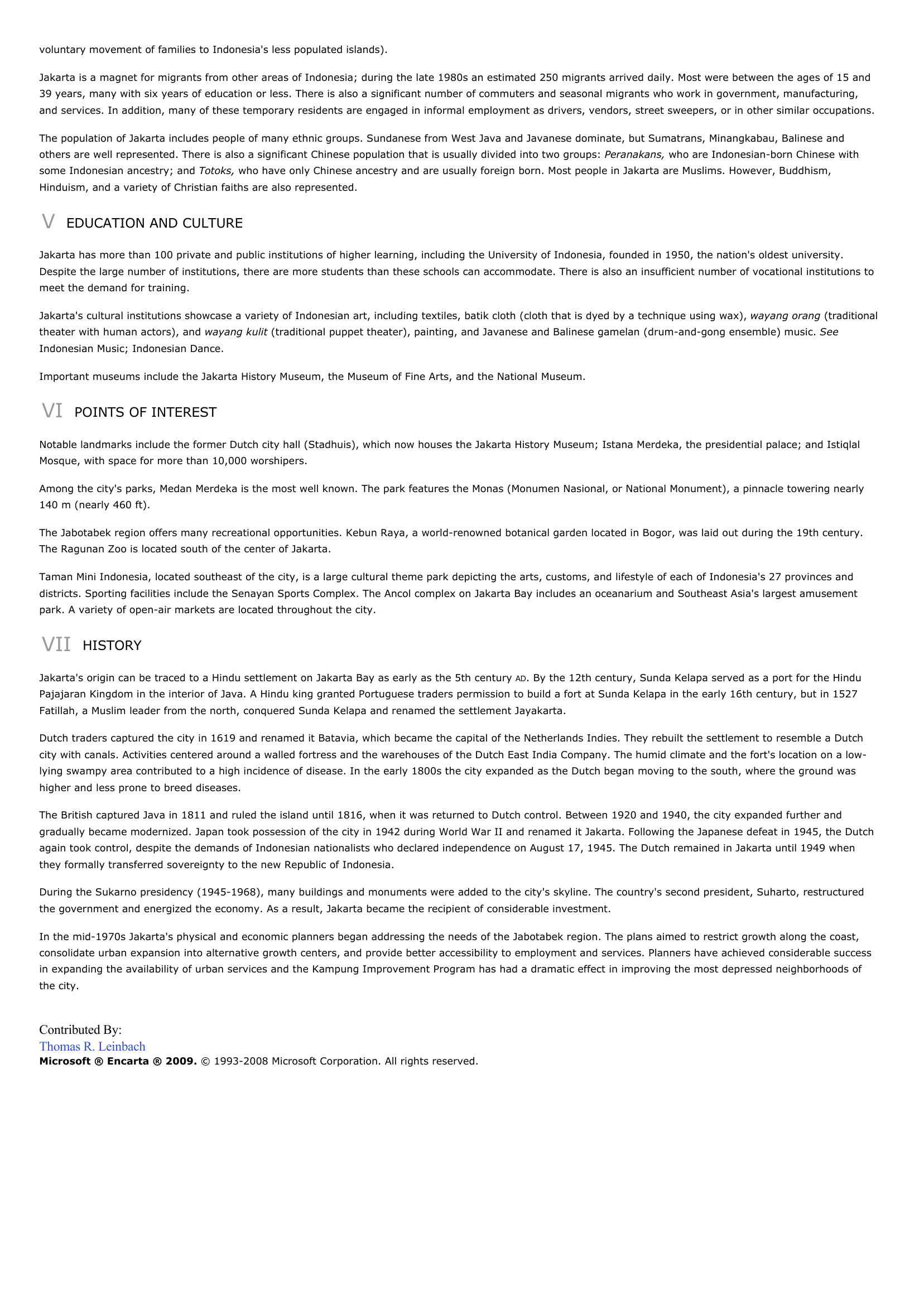Jakarta - geography.
Publié le 04/05/2013

Extrait du document
«
voluntary movement of families to Indonesia's less populated islands).
Jakarta is a magnet for migrants from other areas of Indonesia; during the late 1980s an estimated 250 migrants arrived daily.
Most were between the ages of 15 and39 years, many with six years of education or less.
There is also a significant number of commuters and seasonal migrants who work in government, manufacturing,and services.
In addition, many of these temporary residents are engaged in informal employment as drivers, vendors, street sweepers, or in other similar occupations.
The population of Jakarta includes people of many ethnic groups.
Sundanese from West Java and Javanese dominate, but Sumatrans, Minangkabau, Balinese andothers are well represented.
There is also a significant Chinese population that is usually divided into two groups: Peranakans, who are Indonesian-born Chinese with some Indonesian ancestry; and Totoks, who have only Chinese ancestry and are usually foreign born.
Most people in Jakarta are Muslims.
However, Buddhism, Hinduism, and a variety of Christian faiths are also represented.
V EDUCATION AND CULTURE
Jakarta has more than 100 private and public institutions of higher learning, including the University of Indonesia, founded in 1950, the nation's oldest university.Despite the large number of institutions, there are more students than these schools can accommodate.
There is also an insufficient number of vocational institutions tomeet the demand for training.
Jakarta's cultural institutions showcase a variety of Indonesian art, including textiles, batik cloth (cloth that is dyed by a technique using wax), wayang orang (traditional theater with human actors), and wayang kulit (traditional puppet theater), painting, and Javanese and Balinese gamelan (drum-and-gong ensemble) music.
See Indonesian Music; Indonesian Dance.
Important museums include the Jakarta History Museum, the Museum of Fine Arts, and the National Museum.
VI POINTS OF INTEREST
Notable landmarks include the former Dutch city hall (Stadhuis), which now houses the Jakarta History Museum; Istana Merdeka, the presidential palace; and IstiqlalMosque, with space for more than 10,000 worshipers.
Among the city's parks, Medan Merdeka is the most well known.
The park features the Monas (Monumen Nasional, or National Monument), a pinnacle towering nearly140 m (nearly 460 ft).
The Jabotabek region offers many recreational opportunities.
Kebun Raya, a world-renowned botanical garden located in Bogor, was laid out during the 19th century.The Ragunan Zoo is located south of the center of Jakarta.
Taman Mini Indonesia, located southeast of the city, is a large cultural theme park depicting the arts, customs, and lifestyle of each of Indonesia's 27 provinces anddistricts.
Sporting facilities include the Senayan Sports Complex.
The Ancol complex on Jakarta Bay includes an oceanarium and Southeast Asia's largest amusementpark.
A variety of open-air markets are located throughout the city.
VII HISTORY
Jakarta's origin can be traced to a Hindu settlement on Jakarta Bay as early as the 5th century AD.
By the 12th century, Sunda Kelapa served as a port for the Hindu Pajajaran Kingdom in the interior of Java.
A Hindu king granted Portuguese traders permission to build a fort at Sunda Kelapa in the early 16th century, but in 1527Fatillah, a Muslim leader from the north, conquered Sunda Kelapa and renamed the settlement Jayakarta.
Dutch traders captured the city in 1619 and renamed it Batavia, which became the capital of the Netherlands Indies.
They rebuilt the settlement to resemble a Dutchcity with canals.
Activities centered around a walled fortress and the warehouses of the Dutch East India Company.
The humid climate and the fort's location on a low-lying swampy area contributed to a high incidence of disease.
In the early 1800s the city expanded as the Dutch began moving to the south, where the ground washigher and less prone to breed diseases.
The British captured Java in 1811 and ruled the island until 1816, when it was returned to Dutch control.
Between 1920 and 1940, the city expanded further andgradually became modernized.
Japan took possession of the city in 1942 during World War II and renamed it Jakarta.
Following the Japanese defeat in 1945, the Dutchagain took control, despite the demands of Indonesian nationalists who declared independence on August 17, 1945.
The Dutch remained in Jakarta until 1949 whenthey formally transferred sovereignty to the new Republic of Indonesia.
During the Sukarno presidency (1945-1968), many buildings and monuments were added to the city's skyline.
The country's second president, Suharto, restructuredthe government and energized the economy.
As a result, Jakarta became the recipient of considerable investment.
In the mid-1970s Jakarta's physical and economic planners began addressing the needs of the Jabotabek region.
The plans aimed to restrict growth along the coast,consolidate urban expansion into alternative growth centers, and provide better accessibility to employment and services.
Planners have achieved considerable successin expanding the availability of urban services and the Kampung Improvement Program has had a dramatic effect in improving the most depressed neighborhoods ofthe city.
Contributed By:Thomas R.
LeinbachMicrosoft ® Encarta ® 2009. © 1993-2008 Microsoft Corporation.
All rights reserved..
»
↓↓↓ APERÇU DU DOCUMENT ↓↓↓
Liens utiles
- Jakarta - geography.
- Aceh et Jakarta : deux provinces « particulières », un conflit ?
- Jakarta - geographie.
- Djakarta ou Jakarta.
- Tokyo - geography.










